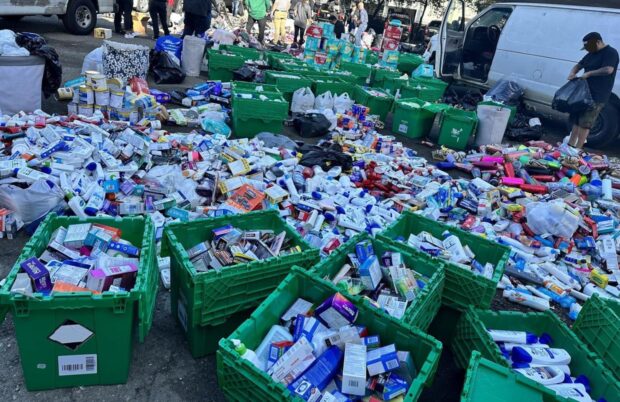An increase in reported shoplifting incidents appear to be higher, in part, due to a rise of such crimes in New York City, posits a new report by the Council on Criminal Justice.
Reported shoplifting incidents in U.S. cities rose in the first half of 2023, compared to levels reported prior to the start of the pandemic.
The analysis, which examined trends in 24 cities “where police have consistently published data over the past five years”, found that shoplifting reports were 16 percent higher (about 8,450 more incidents) during the first half of 2023 compared to the first half of 2019.
Excluding data from New York, the number of shoplifting incidents among the study cities was 7 percent lower (about 2,550 fewer incidents), the CCJ found.
New York (+64 percent) and Los Angeles (+61 percent) recorded the largest increase in reported shoplifting from mid-year 2019 to mid-year 2023.
St. Petersburg (-78 percent) and St. Paul (-65 percent) exhibited the largest decreases.
Recent trends indicate Los Angeles (+109 percent) and Dallas (+73 percent) experienced the largest shoplifting increases among the study cities in the first half of this year compared to the first half of last year, the report found.
San Francisco (-35 percent) and Seattle (-31 percent) reported the biggest drops.
“Shoplifting, especially ‘smash and grab’ episodes caught on video, has received extensive attention from the media and policymakers, and retailers have cited theft concerns in closing stores and placing goods in locked cases,” said CCJ Research Specialist Ernesto Lopez, co-author of the report. “Far better data from law enforcement and the retail industry data is needed to help strengthen our grasp of shoplifting trends. For now, it’s unclear if the increase is a result of increased shoplifting, increased reporting from businesses to police, or a combination of both.”
The analysis, prepared by CCJ’s Crime Trends Working Group, uses data from local law enforcement agencies and the U.S. Justice Department’s National Incident-Based Reporting System (NIBRS).
It is suggested that because the data reflect only reported incidents, the total number of shoplifting incidents is likely undercounted.
Shoplifting remained below pre-pandemic levels through 2022, the Council stated.
Other findings from the analysis include:
- The median value of stolen items rose from about $75 in 2019 to roughly $100 in 2021, the analysis found. Excluding cases ranking in the top 10 percent by value, the value of stolen goods in the vast majority (90 percent) of shoplifting incidents in 2021 was $756 or less, a $184 increase from 2019.
- While shoplifting incidents involving an assault or other crime rose 9 percent from 2019 to 2021, these still constitute a small share (less than 2 percent) of overall shoplifting events, the CCJ researcher stated. Store assaults were 7 percent lower in the first half of 2023 than in the first half of 2022, but 8 percent higher for the same period compared to 2019.
- The share of shoplifting incidents categorized as felonies (in five of the cities) nearly doubled from an estimated 8 percent prior to the pandemic to nearly 16 percent in the first half of 2023. (State statutes set felony theft dollar thresholds.)
- Whether a city experienced a decrease, increase or no change in shoplifting rates from 2018 to 2023 does not appear related to its geographic location, the report found. As an example, three West Coast cities experienced three different trends. Seattle had a moderate decline. After a large spike from September 2021 to April 2022, San Francisco returned to pre-pandemic levels and Los Angeles has seen increased shoplifting rates since the summer of 2021.
“It’s critical that we distinguish quantity from quality,” said CCJ President and CEO Adam Gelb. “The overall data doesn’t indicate a great shift in the average shoplifting event, but the brazen ransacking incidents, coordinated on social media and captured on video, clearly suggest that there is a sense of lawlessness afoot, that anything goes. We typically think of serious violent crimes, like mass shootings, as the offenses that spark fear and drive the politics of crime. But these mass shoplifting events have the potential to derail two decades of criminal justice reform.”
The report was produced with support to the Crime Trends Working Group from the Annie E. Casey Foundation, Arnold Ventures, the Harry Frank Guggenheim Foundation, Southern Company Foundation, and Stand Together Trust, as well as the John D. and Catherine T. MacArthur Foundation and other CCJ general operating contributors.





















 Aon Adds to List of Brokers Suing Howden US for Alleged Poaching, Theft
Aon Adds to List of Brokers Suing Howden US for Alleged Poaching, Theft  The Hardest Part of Innovation in Insurance Isn’t Technology; It’s Culture
The Hardest Part of Innovation in Insurance Isn’t Technology; It’s Culture  AI in Property/Casualty Insurance: Why Trusted Data Is the Missing Link
AI in Property/Casualty Insurance: Why Trusted Data Is the Missing Link  What to Expect in 2026: U.S. P/C Results More Like 2024
What to Expect in 2026: U.S. P/C Results More Like 2024 